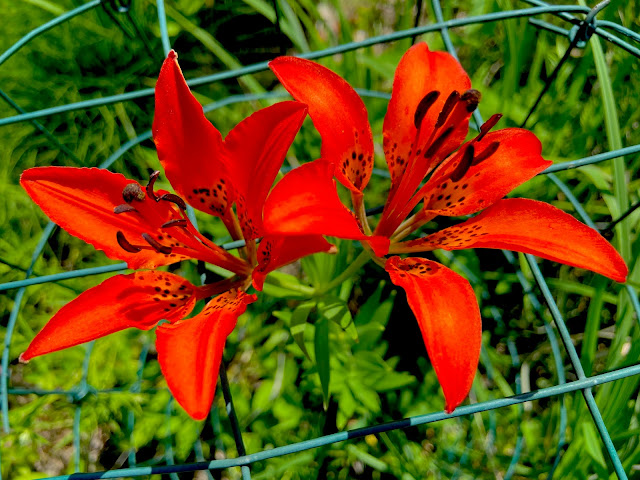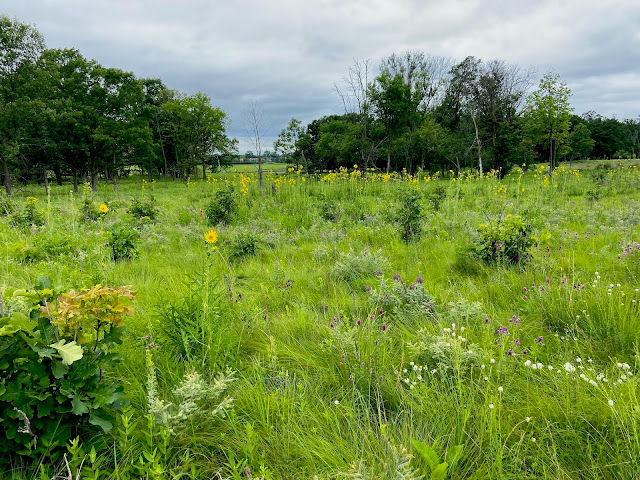A not-highly-organized Photo Essay:
Images and Thoughts from late June and early July 2021
“A thing is right when it tends to preserve the integrity, stability, and beauty of the biotic community. It is wrong when it tends otherwise.”
Aldo Leopold
A Sand County Almanac
Beauty? Do we stewards have to be concerned about our love affair with color?
Yes and no. These colors suggest health and quality because they came together by their own agency as part of the healing process. Beauty sometimes indicates health. But there will be a lot more to say about this.
And what if we tip the camera up and show the background also? Why are so many trees dead?
Are dead trees ugly?Here, under invasive trees until two winters ago, the bare dirt and lack of diversity seem to result from an invasion of woodland sunflower - now dominant and apparently excluding most other vegetation. Fires in this preserve depend on two major fuel types - warm-season grasses and oak leaves. This area has neither, as woodland sunflower is poor fuel. Here, as shown in the foreground, we are scything the sunflowers as an experiment to see whether we can restore diverse fuel species to this area - and whethr such an approach could in time lead to sustainable biodiversity conservation.
If you walk the trails, you may notice that a great many experiments under way at the Somme preserves. In this case a prairie lily peeks out of a deer-exclusion cage. Prairie lily is a rare and highly conservative plant.
On the other hand, recovery of ecosystem diversity and health is not a straight line. The Somme preserves were subjected to a severe drought for the first half of the 2021 growing season. The tall exclusion cage (above) was constructed for the height this lily attained last year. In 2021, it's a third of that height. Natural ecosystems have evolved to weather diverse stresses - within gradually-changing parameters. We expect the recovery to go through twists and turns.
Deer sometimes like to eat purple milkweed, a characteristic savanna species. This uncommon plant increased dramatically under the influence of prescribed burns, as the seed from a few plants blew about the preserve. (We did little or nothing special to help them. That's true for most of the 490 species in this savanna. Others (especially some of the high conservatives that will one day be the core of the ecosystem) need various kinds of intensive care, at least for a while.
The burn scar here is a minor problem. It will be well into its natural successional process in a year or two. But the woodland sunflower and tall goldenrod around it concern us. They resist fire. Areas that don't burn will revert to woody invaders before long.
Step forward a few paces and you can see stumps of two of the large trees that were cut here and burned in that pile. These unnatural trees stood over impoverished vegetation. After the burn though, two aggressive species were taking over. We will scythe them wholesale for a couple of years while seeding to promote more diversity. We get the sense that under some circumstances this approach restores a sustainable plant community ... and under other circumstances it does not. The various approaches are being studied by the Somme Team ( in part coordinated by Karen Glennemeier with a grant from the Illinois Native Plant Society). We learn and report.
This is a somewhat similar area. But here, quality plants are mixed with the aggressive ones. In this case, we will surgically scythe the woodland sunflower and tall goldenrod while protecting the other species. the results are shown below.
This is the same scene, after scything (and removing the scythed material for this photo, so it's easier to see what is left). From the foliage, we can identify cream gentian, wild quinine, golden Alexanders, wild strawberry, rattlesnake master, prairie dock, pale Indian plantain, Culver's root, agrimony, pasture thistle, early goldenrod, Virginia anemone, and others including semi-suppressed grasses and sedges that may make a critical component of the fuel for the fires that may foster increasing quality of this area over the long haul.
In an even shadier area, with lots of oaks and sedges, there's plenty of fuel for fire to repel invaders. The blue flowers belong to heart-leaved skullcap. Those lines arching across this photo are sedges whose long flower stalks seem to be reaching out to plant the seeds just a bit farther away from the mother plant.
Here, in the very open savanna, the fires maintain impressively increasing diversity, but perhaps do it too well for some species? Those clumps of shrubby growths here and there are bur and scarlet oak re-sprouts. They have burned off and stayed small for more than forty years now. The prairie species are doing great! In this former savanna, the "in between" species (not too dark and not too bright) would thrive better if some of the oaks were allowed to grow bigger. For some years now, we've begun working to promote oak reproduction in some areas, as shown below:
We had protected this young bur oak from deer and fire - but then bucks started scraping the bark off the trunk with their antlers. So an additional cage was added to discourage that. It worked. On the other hand, there's a downside to this tree's growing success. Soon it will begin to shade out some of the full-sun dependent species, that we worked so hard to restore here. But the higher goal is to restore the full savanna community, so we'll now work to restore the species of the "in between" - neither full sun nor shade.
In the photo below, the three stages of the drama are visible. In the distance is the completely treeless Somme Prairie. In the foreground is high-quality grassland, former savanna, with bur and scarlet oaks starting to "grow up to be real trees." Here, the "in between" species will increase at the expense of the species more typical of the prairie. In the middle distance are stands of mixed oaks and invasive trees.
In that middle distance, the oaks will be saved here and there, most invaders removed, and the mix of prairie and savanna species seeded in as needed. Savanna restoration is new. There is no place like this on the planet. It's a pleasure and an honor for so many of us to participate in this recovery.
Thanks for joining us for images and thoughts of late June and early July 2021.























No comments:
Post a Comment